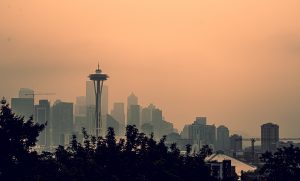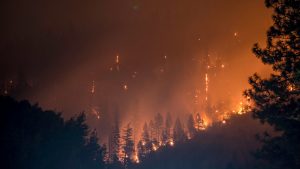The Washington State Department of Natural Resources reported the 2022 wildfire season to be the least destructive in a decade with just over 140,300 acres burned by October 7th. In addition to a dedicated firefighting crew and key partnerships with other agencies, Public Lands Commissioner Hilary Franz credited the passage of HB 1168 – passed unanimously by the Legislature in 2021 – for providing critical investments toward fighting wildfires and improving forest health.
But despite the state facing a less intense fire season this year, Washington state still experienced unhealthy air quality this fall from wildfires. Smoke from the Bolt Creek Fire and Nakia Creek Fire, both in western Washington, blanketed our skies with haze, the smell of smoke and led to road closures and evacuations. On many days, the wildfires created dangerously poor air quality that rivaled other parts of the world.

Smoke from October wildfires blanketed the Puget Sound region with haze and unhealthy air.
Wildfire season offers a time for people throughout the state to better understand the connection between forest health, common sense forestry policies and how both impact human health. The approaches working forests have long practiced – thinning, prescribed burns, planned harvests, and removing underbrush – to grow robust, high-quality trees that can be harvested 35 to 50 years down the road also safeguard overall forest health and improve air and water quality. After all, managed forests are healthy forests that are more resilient in times of stress like drought, disease, infestation, predation and forest fire.
Indeed, forests are not lockboxes that permanently store carbon in perpetuity. The trees that make up a forest are part of a dynamic, living ecosystem. We need look no further than the nearly 100 years of federal fire suppression policy to see how misguided efforts to “save trees” undermined forest health and created dangerous fuel loads that far too often led to forest fires that increased in intensity and size developing into catastrophic megafires.
For the more than 80% of Washington residents who live in urban and suburban areas, forest management and forest practice polices are not a top priority. But when the smoke makes it way west of the Cascades, they become more attuned to the devastating impacts of poorly managed forests. And it is during those moments when voters may be especially receptive to learning about the environmental benefits of working forests, and health experts and policymakers may better appreciate sustainable forestry practices.
Said Franz:
“Bold Creek has reminded us that wildfire doesn’t see boundaries. As climate change and other factors have worsened the length and impact of fires seasons, turning them instead to fire years, wildfire is no longer an eastside issue – it’s a statewide one.”

